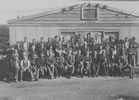In 2006, there were 15 commercially operated ski and snowboard areas in New Zealand. Commercial skifields were slow to develop, although top Austrian skier Ernst Skardarasy asserted in 1937 that New Zealand was potentially better than Australia for skiing.
Accommodation and transport
First, skiers needed suitable accommodation. Two tourist hotels were developed near skiing areas in the early 20th century. One was the Hermitage, at Aoraki/Mt Cook village, which had been established as a hostel in the 19th century. The other was New Zealand’s nearest equivalent to a European 'grand hotel’, the Chateau Tongariro, which opened underneath Mt Ruapehu in 1929.
Both hotels, however, were several kilometres from skiing slopes. In Europe, ski resorts were typically established near high-alpine settlements, built centuries earlier. People could reach the skifields using extensions of existing transport networks. In New Zealand, transport often did not exist. Skiers had to walk or climb to the slopes, often far away. There were no rack railways or cablecars, which predated skiing in the European Alps. A basic ski tow was trialled briefly at Mt Ruapehu in 1938, but others were not built until after the Second World War.
Learning to ski
Ski instruction was an important factor in the development of commercial fields. Ruapehu, for example, became more popular when ski schools were set up there. Top Austrian skier Ernst Skardarasy started teaching the sport in 1938, and was succeeded by Swiss instructor Walter Haensli in 1949. Haensli proposed the first commercial chairlift, which was installed at Ruapehu in 1954.
Post-war transport
In 1947 a rope ski tow, designed by inventor Bill Hamilton, was installed at Coronet Peak – the first of a number built at different skifields. The first chairlift was opened in 1954, and the first Pomalski drag lift in 1961, both at Ruapehu. T-bar lifts were gradually introduced on some commercial and club fields. Skiplanes were modified in New Zealand for landing on the large glaciers. The first skiplane flew from Mt Cook village in 1955. Skiplanes turned the Tasman Glacier into a ski run, and are still popular in this region.
Major commercial skifields
These innovations, and the development of the tourism industry after the Second World War, fostered the growth of commercial ski areas. By the 1970s they had begun to dominate skiing in New Zealand. In the early 21st century the main areas were:
- Coronet Peak, near Queenstown, the first commercial field, opened in 1947. This is the nearest to a European-style resort in New Zealand, but its relatively low altitude means there is not always enough snow.
- Mt Hutt in Canterbury, opened in 1973. Slightly higher than southern areas, it has a long season. Transport problems were solved by building an access road – at that time the longest and highest at any New Zealand skifield.
- The Whakapapa (1953) and Tūroa (1979) fields at Mt Ruapehu. Ruapehu has the largest ski area in the southern hemisphere.
- Treble Cone, near Lake Wānaka, opened in 1976 and was later extended. This field attracts both overseas tourists and New Zealanders.
- Cardrona, between Wānaka and Queenstown, opened in 1977. This area has a good range of slopes for all levels of ability.
- The Remarkables, near Queenstown, opened in 1985. This was a world-class field from the start.
These commercial skifields compare well internationally. Facilities have been upgraded in recent decades, and snow-making and snow-grooming is carried out regularly.



